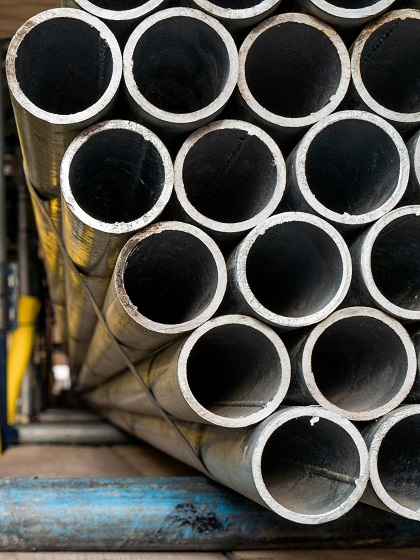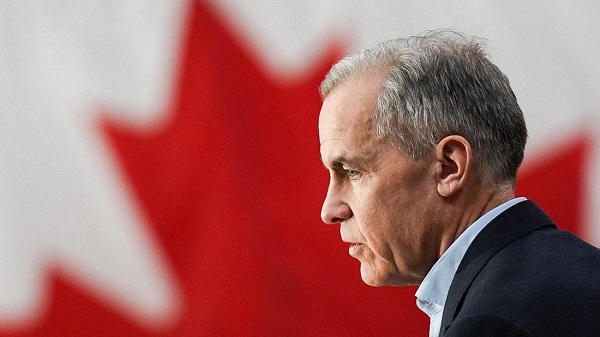Business
Trump imposes 25 percent tariff on all foreign steel, aluminum imports

Quick Hit:
President Donald Trump announced Sunday that he will impose a 25% tariff on all foreign steel and aluminum imports starting Monday. Speaking from Air Force One, Trump said the tariffs will apply to all countries, including key U.S. allies like Canada and Mexico. He also plans to unveil reciprocal tariffs on trading partners within days.
Key Details:
- Trump’s tariffs target steel and aluminum imports from all nations, including top suppliers Canada, Brazil, Mexico, South Korea, and Vietnam. Canada is also the leading source of U.S. aluminum imports.
- This move is part of Trump’s broader trade agenda, which has included tariffs on China and previous levies on Canada and Mexico. His first-term steel and aluminum tariffs sparked tensions with allies but led to renegotiated trade agreements.
- Trump’s proposal for reciprocal tariffs could trigger global trade disputes. He plans to announce these new measures midweek, stating, “If they charge us, we charge them.” Critics warn such tariffs could violate World Trade Organization rules.
Diving Deeper:
President Donald Trump announced a sweeping 25% tariff on all imported steel and aluminum, reigniting trade battles that defined his first term. Speaking aboard Air Force One while traveling to the Super Bowl, Trump confirmed that the tariffs would take effect Monday and apply to “everybody,” including major U.S. trading partners.
“Any steel coming into the United States is going to have a 25 percent tariff,” Trump said. “Aluminum, too.”
The decision marks a sharp escalation in Trump’s ongoing trade strategy, which has already led to tariffs on China and threats against European nations, Taiwan, and other key trading partners. Trump’s push for reciprocal tariffs—set to be detailed later this week—aims to raise U.S. import duties to match those imposed by foreign nations on American goods.
The impact of Trump’s steel and aluminum tariffs will be particularly significant for Canada, the largest supplier of both metals to the U.S. Other top steel providers include Brazil, Mexico, South Korea, and Vietnam. Aluminum imports primarily come from Canada, followed by the United Arab Emirates, Russia, and China.
Trump’s decision mirrors actions taken during his first term when he imposed broad steel and aluminum tariffs, triggering backlash from allies. He later eased restrictions on Canada and Mexico after renegotiating trade agreements. The Biden administration subsequently reached separate agreements with the European Union, the United Kingdom, and Japan, allowing some of those trade barriers to be reduced.
It remains unclear whether Trump’s new tariffs will be in addition to those still in place or replace existing measures. Either way, the move is likely to spark further retaliation from foreign governments.
Trump’s aggressive stance on trade has already disrupted global markets in recent days with frequent tariff threats. His proposed reciprocal tariffs, set to be announced Tuesday or Wednesday, are expected to take effect “almost immediately” and could violate World Trade Organization commitments.
“Very simply, if they charge us, we charge them,” Trump said.
As Trump moves forward with his latest round of trade measures, the global economic response remains uncertain. What is clear, however, is that his trade agenda remains a central pillar of his economic policy, setting the stage for renewed tensions with key allies and trading partners.
Business
Capital Flight Signals No Confidence In Carney’s Agenda

From the Frontier Centre for Public Policy
By Jay Goldberg
Between bad trade calls and looming deficits, Canada is driving money out just when it needs it most
Canadians voted for relative continuity in April, but investors voted with their wallets, moving $124 billion out of the country.
According to the National Bank, Canadian investors purchased approximately $124 billion in American securities between February and July of this year. At the same time, foreign investment in Canada dropped sharply, leaving the country with a serious hole in its capital base.
As Warren Lovely of National Bank put it, “with non-resident investors aloof and Canadians adding foreign assets, the country has suffered a major capital drain”—one he called “unprecedented.”
Why is this happening?
One reason is trade. Canada adopted one of the most aggressive responses to U.S. President Donald Trump’s tariff agenda. Former prime minister Justin Trudeau imposed retaliatory tariffs on the United States and escalated tensions further by targeting goods covered under the Canada–United States–Mexico Agreement (CUSMA), something even the Trump administration avoided.
The result was punishing. Washington slapped a 35 per cent tariff on non-CUSMA Canadian goods, far higher than the 25 per cent rate applied to Mexico. That made Canadian exports less competitive and unattractive to U.S. consumers. The effects rippled through industries like autos, agriculture and steel, sectors that rely heavily on access to U.S. markets. Canadian producers suddenly found themselves priced out, and investors took note.
Recognizing the damage, Prime Minister Mark Carney rolled back all retaliatory tariffs on CUSMA-covered goods this summer in hopes of cooling tensions. Yet the 35 per cent tariff on non-CUSMA Canadian exports remains, among the highest the U.S. applies to any trading partner.
Investors saw the writing on the wall. They understood Trudeau’s strategy had soured relations with Trump and that, given Canada’s reliance on U.S. trade, the United States would inevitably come out on top. Parking capital in U.S. securities looked far safer than betting on Canada’s economy under a government playing a weak hand.
The trade story alone explains much of the exodus, but fiscal policy is another concern. Interim Parliamentary Budget Officer Jason Jacques recently called Ottawa’s approach “stupefying” and warned that Canada risks a 1990s-style fiscal crisis if spending isn’t brought under control. During the 1990s, ballooning deficits forced deep program cuts and painful tax hikes. Interest rates soared, Canada’s debt was downgraded and Ottawa nearly lost control of its finances. Investors are seeing warning signs that history could repeat itself.
After months of delay, Canadians finally saw a federal budget on Nov. 4. Jacques had already projected a deficit of $68.5 billion when he warned the outlook was “unsustainable.” National Bank now suggests the shortfall could exceed $100 billion. And that doesn’t include Carney’s campaign promises, such as higher defence spending, which could add tens of billions more.
Deficits of that scale matter. They can drive up borrowing costs, leave less room for social spending and undermine confidence in the country’s long-term fiscal stability. For investors managing pensions, RRSPs or business portfolios, Canada’s balance sheet now looks shaky compared to a U.S. economy offering both scale and relative stability.
Add in high taxes, heavy regulation and interprovincial trade barriers, and the picture grows bleaker. Despite decades of promises, barriers between provinces still make it difficult for Canadian businesses to trade freely within their own country. From differing trucking regulations to restrictions on alcohol distribution, these long-standing inefficiencies eat away at productivity. When combined with federal tax and regulatory burdens, the environment for growth becomes even more hostile.
The Carney government needs to take this unprecedented capital drain seriously. Investors are not acting on a whim. They are responding to structural problems—ill-advised trade actions, runaway federal spending and persistent barriers to growth—that Ottawa has yet to fix.
In the short term, that means striking a deal with Washington to lower tariffs and restore confidence that Canada can maintain stable access to U.S. markets. It also means resisting the urge to spend Canada into deeper deficits when warning lights are already flashing red. Over the long term, Ottawa must finally tackle high taxes, cut red tape and eliminate the bureaucratic obstacles that stand in the way of economic growth.
Capital has choices. Right now, it is voting with its feet, and with its dollars, and heading south. If Canada wants that capital to come home, the government will have to earn it back.
Jay Goldberg is a fellow with the Frontier Centre for Public Policy.
Business
Budget 2025 continues to balloon spending and debt

The Canadian Taxpayers Federation is criticizing Prime Minister Mark Carney for ballooning spending and debt in Budget 2025.
“Budget 2025 shows the debt continues to spiral out of control because spending continues to spiral out of control,” said Franco Terrazzano, CTF Federal Director. “Carney needs to reverse course to get debt and spending under control because every dollar Canadians pay in federal sales tax is already going to pay interest charges on the debt.
“Carney isn’t close to balancing anything when he’s borrowing tens of billions of dollars every year.”
The federal deficit will increase significantly this year to $78.3 billion. There is no plan to balance the budget and stop borrowing money. The federal debt will reach $1.35 trillion by the end of this year.
Debt interest charges will cost taxpayers $55.6 billion this year, which is more than the federal government will send to the provinces in health transfers ($54.7 billion) or collect through the GST ($54.4 billion).
Budget 2025 increases spending by $38 billion this year to $581 billion. Despite promises to control spending in future years, Budget 2025 projects that overall spending will continue to rise by billions every year.
“Canadians don’t need another plan to create a plan to meet about cutting spending, Canadians need real spending cuts now,” Terrazzano said. “The government always tells Canadians that it will go on a diet Monday, but Monday never comes.
“And the government isn’t really finding savings if it’s planning to keep increasing spending every year.”
Budget 2025 commits to “strengthening” the industrial carbon tax and “setting a multi-decade industrial carbon price trajectory that targets net zero by 2050.”
“Carney’s hidden carbon tax will make it harder for Canadian businesses to compete and will push Canadian entrepreneurs to set up shop south of the border,” Terrazzano said. “Carney should scrap all carbon taxes, cut spending and stop taking so much money from taxpayers.”
-

 Brownstone Institute1 day ago
Brownstone Institute1 day agoBizarre Decisions about Nicotine Pouches Lead to the Wrong Products on Shelves
-

 Business2 days ago
Business2 days agoCarney government should retire misleading ‘G7’ talking point on economic growth
-

 Alberta2 days ago
Alberta2 days agoCanada’s heavy oil finds new fans as global demand rises
-

 Censorship Industrial Complex1 day ago
Censorship Industrial Complex1 day agoPro-freedom group warns Liberal bill could secretly cut off Canadians’ internet access
-

 Bruce Dowbiggin1 day ago
Bruce Dowbiggin1 day agoA Story So Good Not Even The Elbows Up Crew Could Ruin It
-

 Daily Caller2 days ago
Daily Caller2 days agoNigeria Would Welcome US Intervention In Massacre Of Christians By Islamic Terror Groups
-

 Automotive2 days ago
Automotive2 days agoCanada’s EV experiment has FAILED
-

 Business1 day ago
Business1 day agoCarney government’s first budget should signal end to crippling ‘climate’ policies








